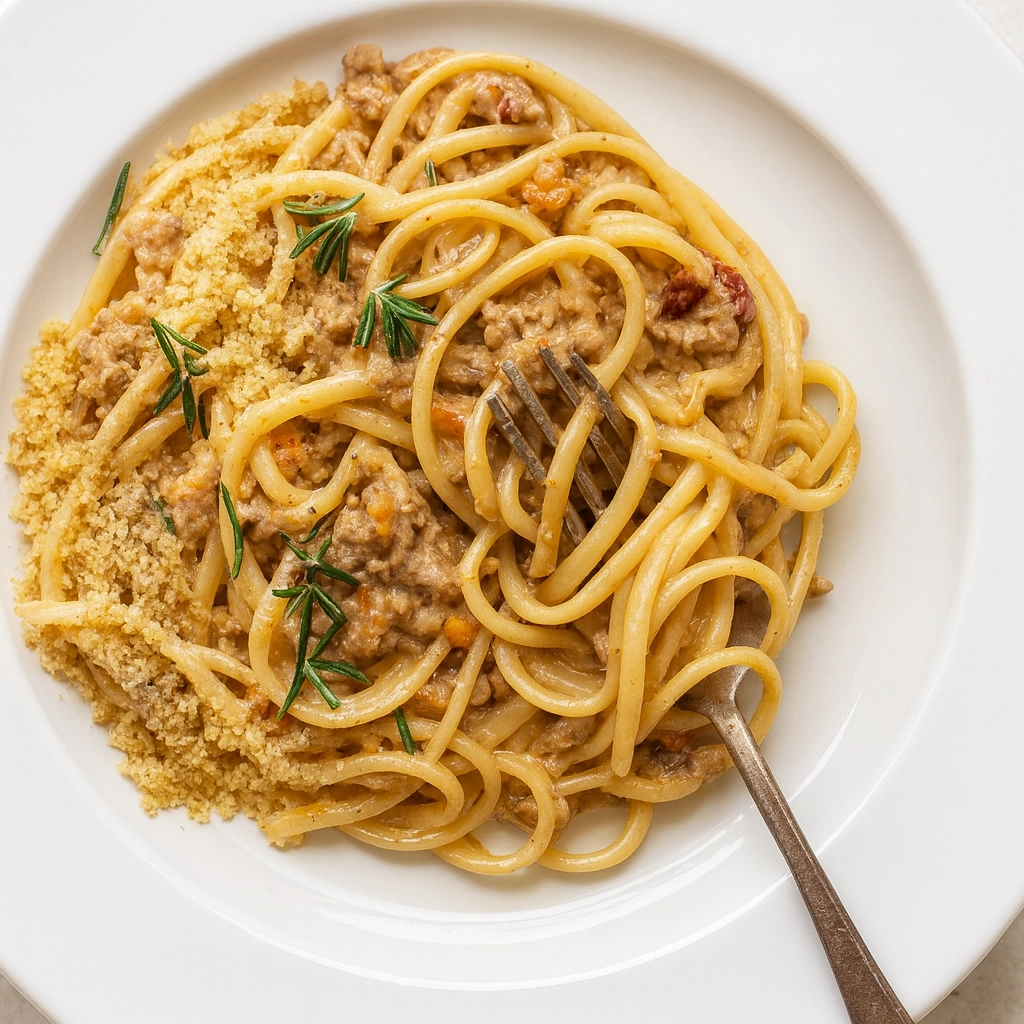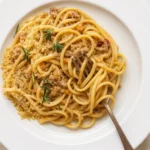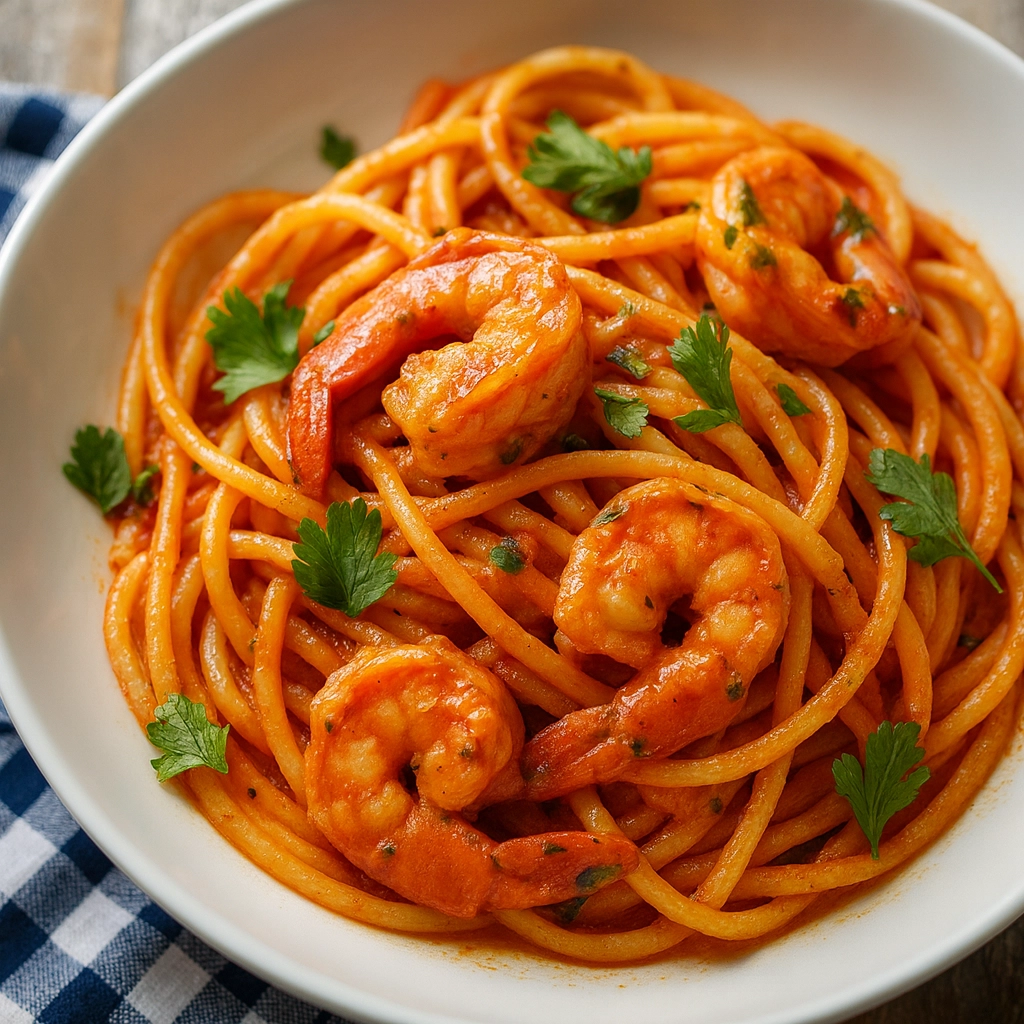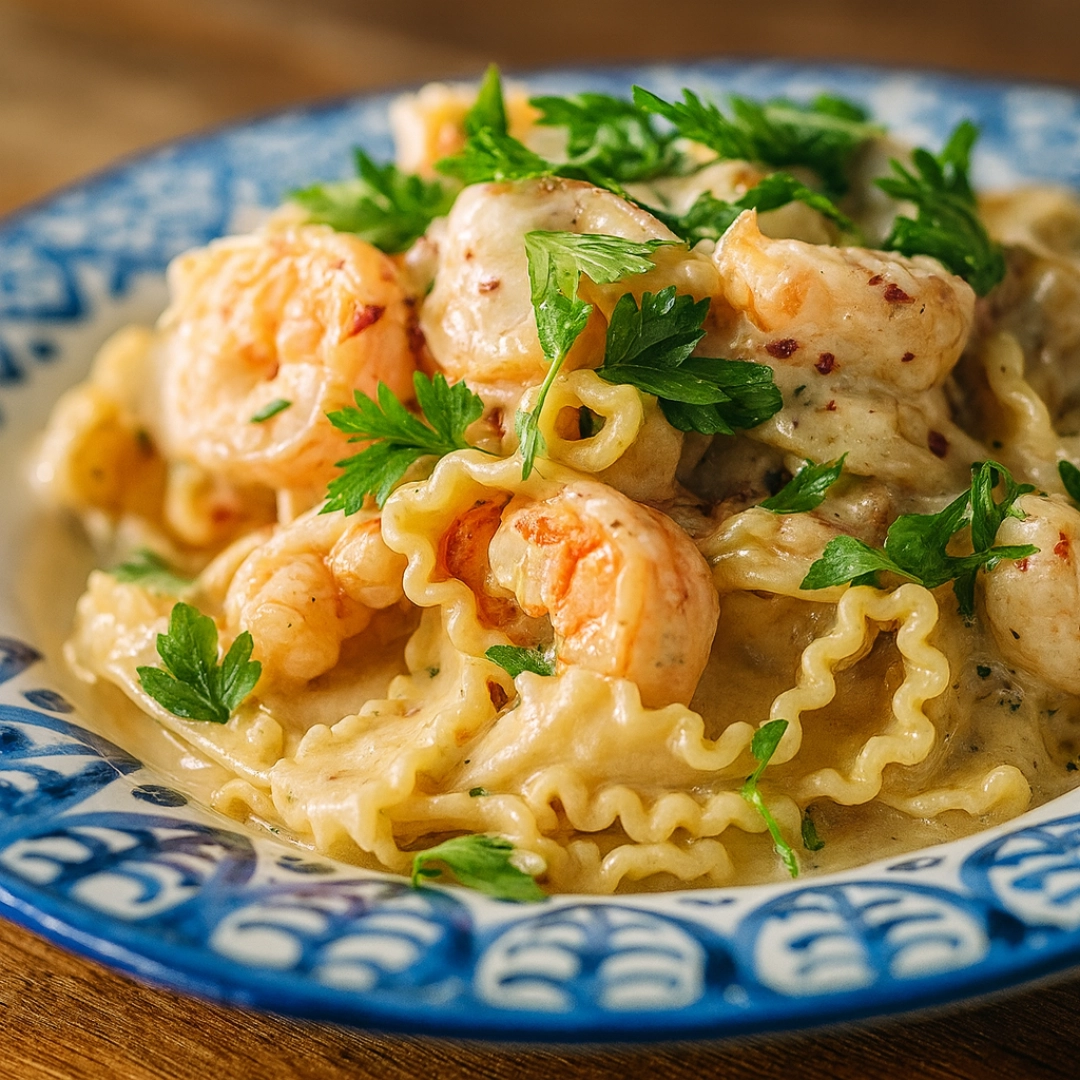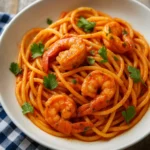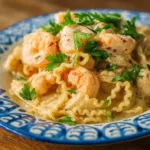If you’ve only ever had the classic red version, this white spaghetti bolognese will change the way you think about comfort pasta. Known in Italy as ragu bianco, this dish is a slow-simmered meat sauce made without tomatoes, relying instead on white wine, milk, chicken stock, and fresh herbs to build layers of flavor. The result is a creamy, savory sauce that clings beautifully to strands of spaghetti rich enough for a dinner party yet simple enough for a cozy weeknight meal.
Unlike its tomato-based cousin, white bolognese has a lighter, silkier taste. The addition of pancetta, soffritto (onion, carrot, and celery), and a squeeze of lemon gives it both depth and brightness. Tossed with spaghetti and finished with parmesan, it’s Italian comfort food at its finest.
This content is for educational purposes only and does not replace professional dietary or medical advice.
Table of Contents
What is White Spaghetti Bolognese?
White spaghetti bolognese, often called ragu bianco in Italian kitchens, is a tomato-free twist on the traditional bolognese sauce. Instead of relying on slow-cooked tomatoes, this sauce builds its richness from a base of pancetta, soffritto (a finely diced mix of onion, carrot, and celery), and ground meats simmered in white wine, milk, and chicken stock.
The absence of tomato gives the dish a lighter profile, yet it still delivers incredible depth thanks to herbs like rosemary and sage, plus the umami kick of parmesan and pancetta. A final touch of lemon juice and zest brightens the sauce, keeping it from feeling too heavy.
Spaghetti is the ideal pasta pairing because its long strands soak up the velvety sauce, creating a luxurious bite in every forkful. While Italians often use tagliatelle or pappardelle for ragu, serving this version with spaghetti makes it both familiar and elegant perfect for anyone trying white bolognese for the first time.
Key Ingredients You’ll Need
The beauty of white spaghetti bolognese is in its simplicity. Each ingredient plays a role in building layers of flavor, so choosing the right components makes all the difference.
Ground Meat
A traditional ragu bianco uses a mix of pork and beef, which balances richness with depth. You can also substitute ground veal, chicken, or turkey for a lighter version.
Pancetta
Pancetta provides a salty, savory backbone to the sauce. If you can’t find it, good-quality bacon is an excellent substitute.
Soffritto
This trio of onion, carrot, and celery forms the flavor base. Chop it finely (or pulse in a food processor) to help it melt into the sauce without overpowering.
Fresh Herbs
Rosemary and sage are the classic pairing, though thyme can also be added for extra aroma. Always use fresh herbs if possible.
White Wine
A dry white wine, such as Sauvignon Blanc or Pinot Grigio, adds acidity and depth. The alcohol cooks off, leaving behind only a subtle richness.
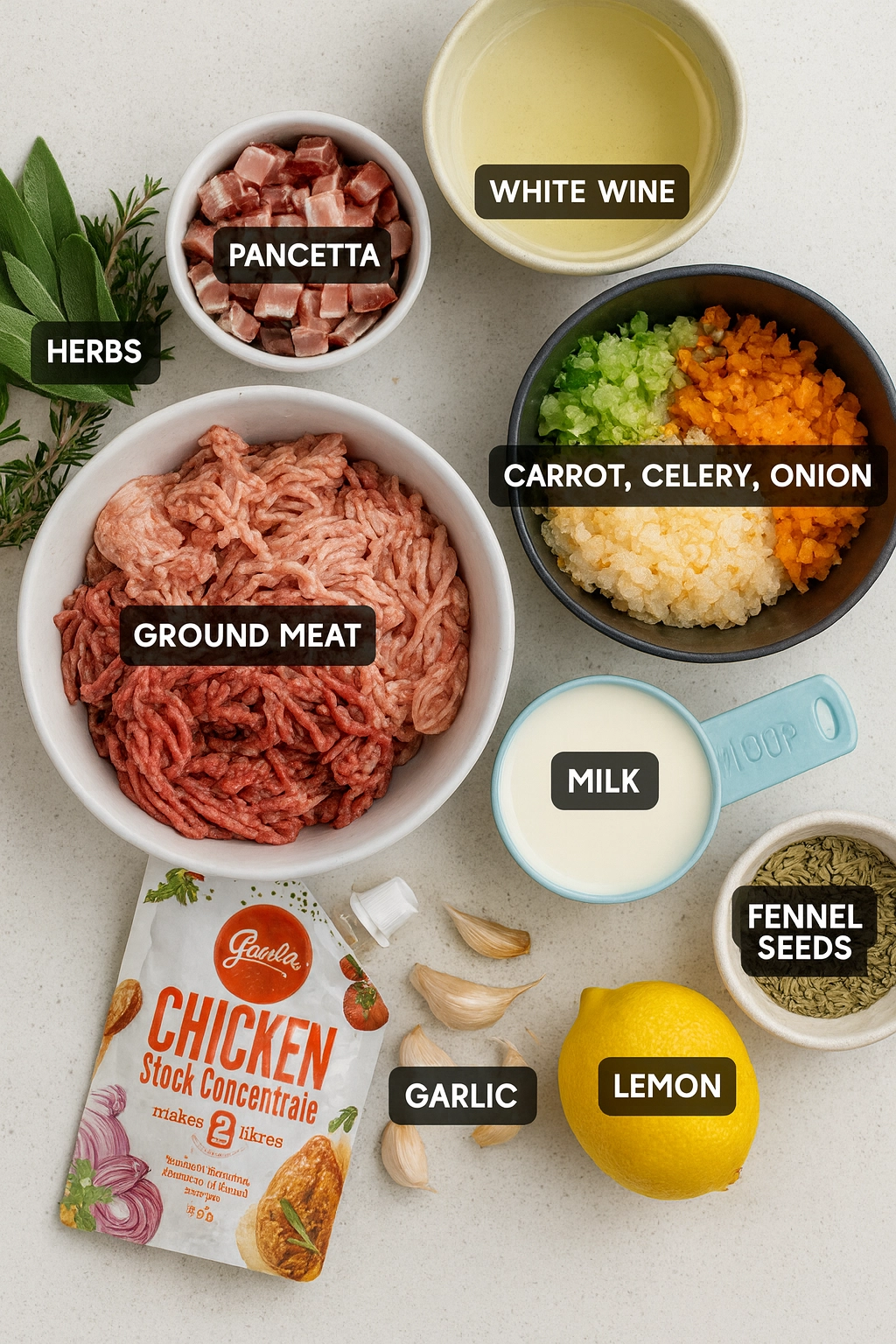
Whole Milk
Cooking meat in milk is a traditional Italian technique that tenderizes the meat and creates a creamy sauce. Don’t substitute with skim milk fat content matters here.
Chicken Stock
Provides body and a savory base. Homemade is ideal, but a good-quality store-bought stock works well.
Lemon
Fresh lemon juice and zest cut through the richness of the sauce, giving it a clean finish.
Parmesan Cheese
Adds nutty, salty depth when stirred into the pasta and sprinkled on top before serving.
Pasta Choice: Spaghetti
While wide noodles like tagliatelle are often paired with bolognese, spaghetti gives this white version a familiar yet elevated feel. The long strands soak up the sauce beautifully.
Looking for more pasta inspiration? Try our lemon parmesan pasta or French onion pasta for other rich and comforting flavors.
Step-by-Step Guide to Making White Bolognese
Cooking white spaghetti bolognese takes time, but most of it is hands-off simmering. Here’s how to bring out maximum flavor in each stage:
1. Brown the Meat
Heat olive oil in a heavy-bottomed pot or Dutch oven. Add the ground pork and beef, letting them sear until browned. Avoid stirring too much allowing the meat to caramelize adds depth. Remove and set aside.
2. Render the Pancetta
In the same pot, fry the pancetta until golden and crispy. This step infuses the base with salty, smoky richness. Lift the pancetta out but leave the flavorful fat behind.
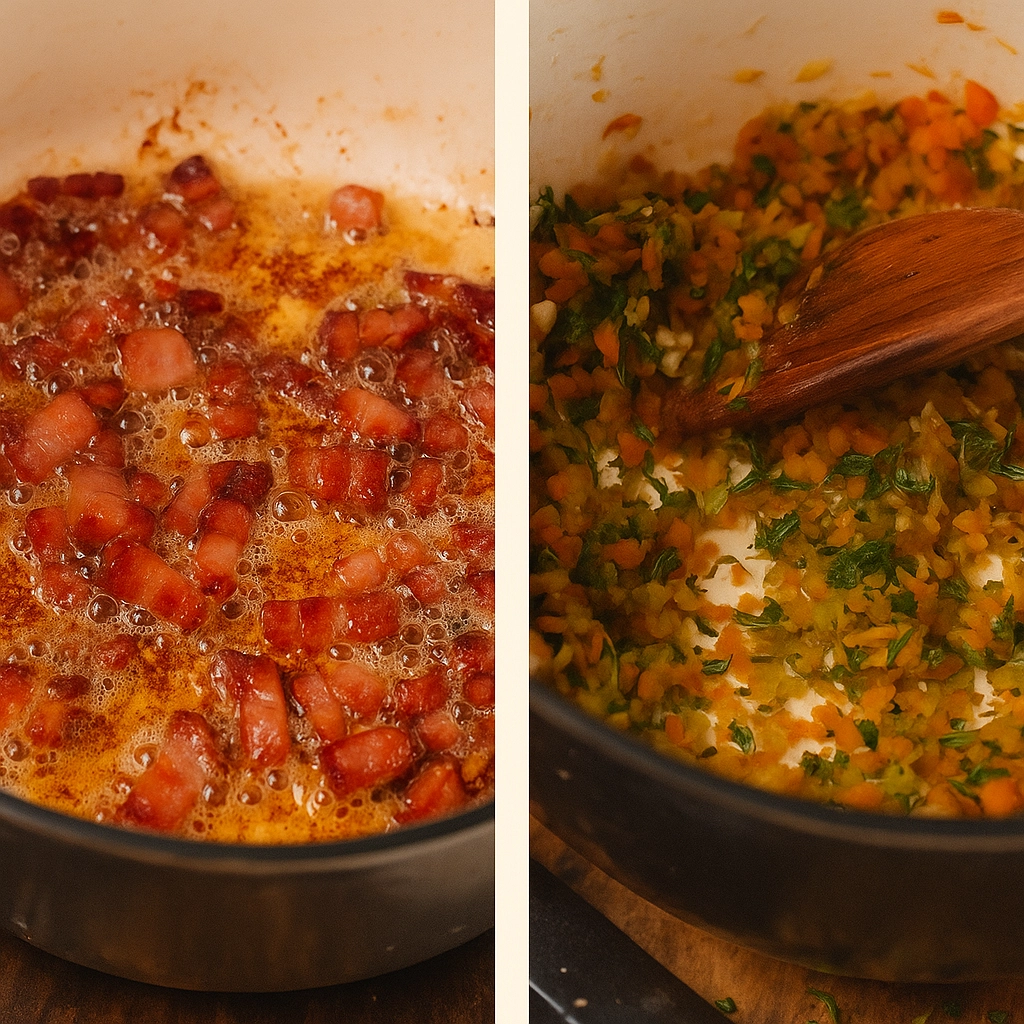
3. Cook the Soffritto
Add finely diced onion, carrot, and celery to the pancetta fat. Cook slowly until softened and fragrant, about 10 minutes. Stir in garlic, fennel seeds, and fresh herbs halfway through.
4. Deglaze with Wine
Return the browned meat and pancetta to the pot. Pour in white wine and let it reduce for 3–4 minutes, scraping the bottom of the pan to release browned bits.
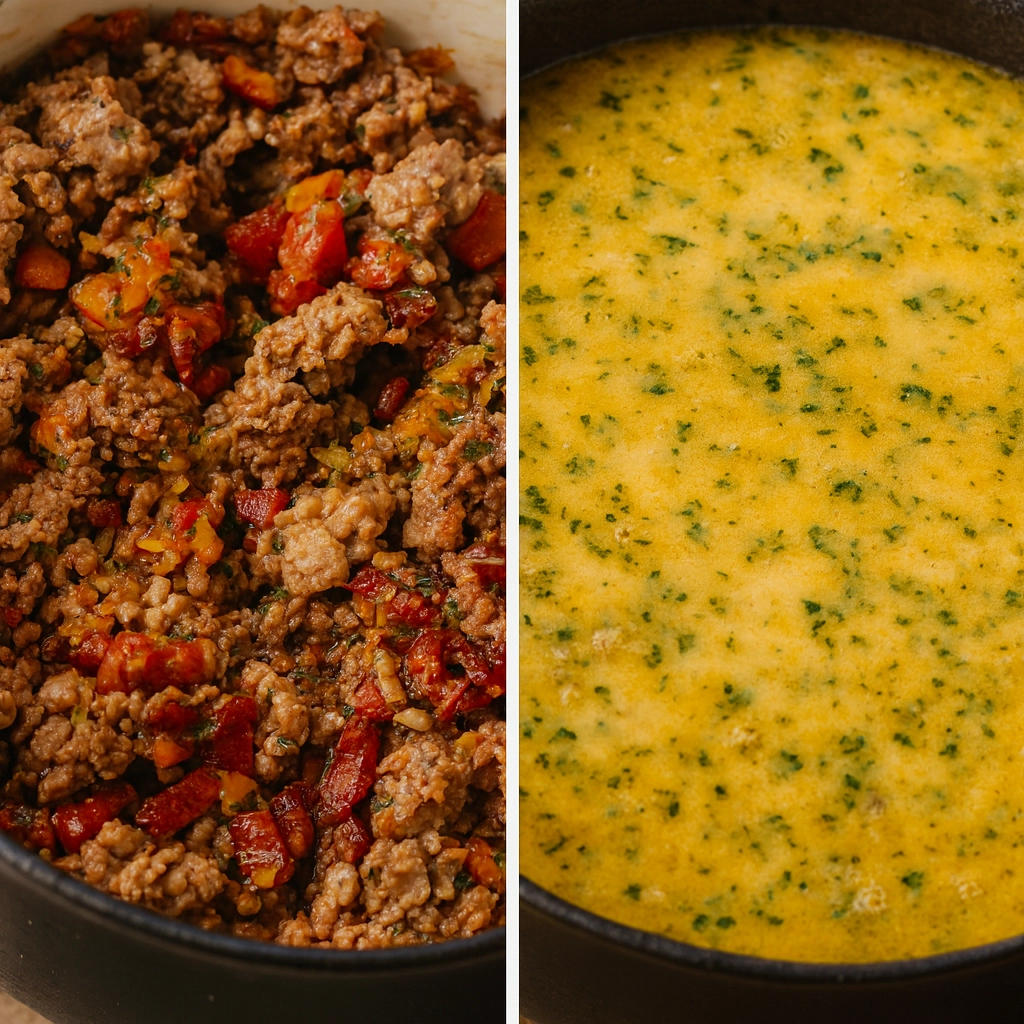
5. Add Stock and Milk
Pour in chicken stock and whole milk, then bring to a gentle simmer. Lower the heat until the sauce barely bubbles. This slow simmering allows the flavors to meld while the meat becomes tender. Cook uncovered for 2½ to 3 hours, stirring occasionally.
6. Finish the Sauce
When the liquid has mostly reduced, stir in lemon juice, cream (if using), and plenty of freshly grated parmesan. Taste and adjust seasoning with salt and pepper.
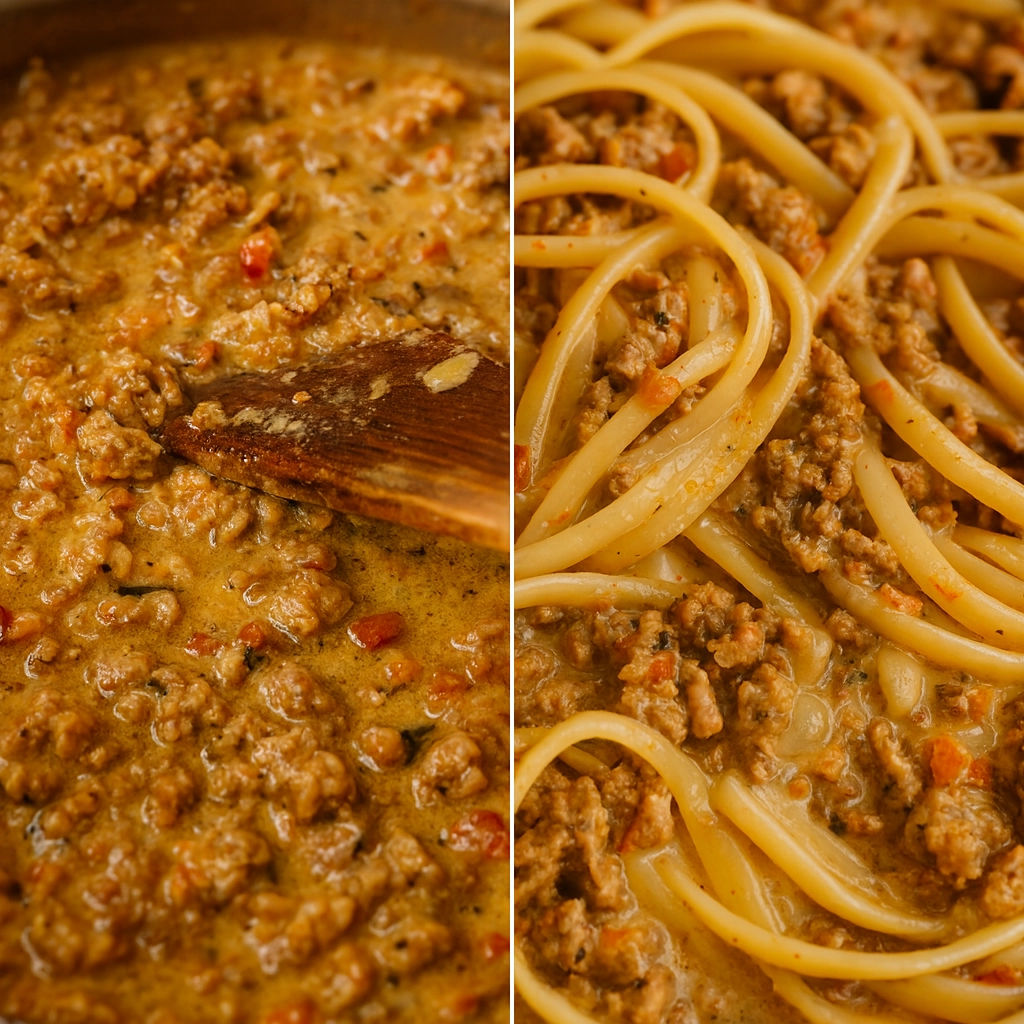
7. Toss with Spaghetti
Cook spaghetti until just shy of al dente. Add it directly into the sauce, along with a splash of pasta water. Let it simmer for 2–3 minutes so the noodles absorb the flavors.
8. Serve & Garnish
Top with lemon zest, fresh rosemary, and an extra shower of parmesan. Serve immediately while hot and creamy.
For another comforting pasta recipe, try our roast tomato pasta sauce or cheesecake factory tomato basil pasta for a tomato-based twist.
Pro Tips for the Best White Spaghetti Bolognese
Getting white bolognese right is all about patience and small details. These tips will help you achieve a sauce that’s silky, rich, and unforgettable.
Prep Everything Before You Start
Finely chop your soffritto, measure out your stock and wine, and have herbs ready. Good prep keeps the cooking process smooth and stress-free.
Don’t Rush the Browning
Caramelization equals flavor. Take the time to properly brown your meat and pancetta before moving on this step builds the sauce’s foundation.
Keep the Heat Low for the Simmer
White bolognese should bubble so gently that it’s almost still. A low, slow simmer ensures the meat becomes tender and the sauce develops its signature depth.
Undercook the Pasta
Boil your spaghetti one minute less than the package suggests. Letting it finish in the sauce helps it absorb flavor while staying perfectly al dente.
Make It Ahead
White bolognese tastes even better the next day. Prepare it ahead of time for dinner parties or busy weeknights it reheats beautifully.
Store & Reheat Like a Pro
- Refrigerate in an airtight container for up to 3 days.
- Freeze for up to 3 months.
- Reheat gently on the stove with a splash of pasta water or stock to loosen.
If you enjoy pasta dishes that develop more flavor overnight, you might also love our Polish strawberry pasta for a sweet-summer twist.
Serving Suggestions & Variations
One of the best things about white spaghetti bolognese is how versatile it can be. Whether you’re serving a casual family dinner or hosting guests, this dish adapts beautifully.
Best Pasta Pairings
- Spaghetti – the classic choice, perfect for soaking up creamy sauce.
- Tagliatelle or Pappardelle – wide ribbons that hold more sauce.
- Rigatoni – for those who prefer a chunky pasta shape.
Lighter Options
- Swap pork and beef for ground turkey or chicken.
- Use half-and-half instead of cream.
- Add extra vegetables like mushrooms or zucchini to bulk up the sauce.
Creative Leftover Ideas
- Lasagna – replace tomato bolognese with white bolognese for a rich twist.
- Baked Pasta – layer with cheese, bake until golden, and serve as a hearty casserole.
- Ravioli Filling – use reduced sauce as a luxurious stuffing for fresh pasta.
Wine Pairing
This dish pairs beautifully with dry white wines like Pinot Grigio, Sauvignon Blanc, or even a lightly oaked Chardonnay. If you prefer red, choose something light and earthy such as Pinot Noir.
White Spaghetti Bolognese vs Classic Red Bolognese
Both versions of bolognese are hearty and comforting, but they highlight different flavor profiles:
Flavor
- White Bolognese – creamy, savory, and aromatic with subtle sweetness from milk and herbs. The lemon zest adds brightness.
- Red Bolognese – richer, deeper, and slightly acidic thanks to tomatoes and red wine.
Texture
- White – silkier and lighter, clings smoothly to spaghetti strands.
- Red – thicker, with more body from tomatoes and longer cooking reduction.
When to Choose Each
- Choose white bolognese for a refined, elegant pasta dish that feels luxurious but not heavy.
- Choose red bolognese when you want a bold, classic comfort food that pairs well with rustic bread and hearty red wine.
If you’re a tomato lover, don’t miss our cheesecake factory tomato basil pasta for a vibrant red-based option.
Love quick, flavorful meals? Don’t miss out!
Join us on Pinterest for beautiful food boards, meal prep hacks, and family go-to recipes: Flavour Recipe Pinterest
Let’s get cooking and make something delicious together!
FAQs About White Spaghetti Bolognese
What is white bolognese made of?
White bolognese (or ragu bianco) is made with ground meat, pancetta, soffritto (onion, carrot, celery), white wine, milk, and chicken stock. It’s finished with parmesan, herbs, and lemon zest instead of tomatoes.
How to make white sauce for bolognese?
The “white sauce” comes naturally from simmering milk and stock with the browned meat. As the mixture reduces over low heat, it creates a creamy, flavorful sauce without needing flour or heavy cream.
How does white bolognese differ from red?
Red bolognese uses tomatoes and red wine for depth and acidity, while white bolognese relies on milk, stock, and white wine for a lighter, creamier finish. Both are slow-cooked for richness, but the flavors are distinctly different.
What is white sauce for spaghetti?
In this context, the white sauce is the tomato-free ragu bianco that coats the spaghetti. It’s not the same as Alfredo sauce—white bolognese has a savory, meaty base instead of relying on cream and butter.
White Spaghetti Bolognese Recipe (Rich & Creamy Italian Classic)
A rich, tomato-free ragu bianco simmered with white wine, milk, pancetta, and herbs, tossed with spaghetti for a creamy, elegant pasta dinner.
- Prep Time: 15 mins
- Cook Time: 3 hrs
- Total Time: 3 hrs 15 mins
- Yield: 4–6 servings 1x
- Category: Dinner
- Method: Stovetop
- Cuisine: Italian
Ingredients
2 tbsp olive oil, divided
300 g (10 oz) ground pork
300 g (10 oz) ground beef
120 g (4 oz) pancetta, diced (or bacon)
1 medium onion, finely diced
1 carrot, finely diced
1 celery stalk, finely diced
2 tsp fennel seeds
4–5 garlic cloves, minced
2 tbsp fresh rosemary, chopped
2 tbsp fresh sage, chopped
1 1/2 cups dry white wine (Sauvignon Blanc or Pinot Grigio)
1 cup whole milk
2 cups chicken stock
1/2 tbsp fresh lemon juice (plus zest to finish)
1/4 cup cream (optional)
450 g (1 lb) spaghetti
Salt and freshly ground black pepper, to taste
Freshly grated parmesan, for serving
Instructions
1. Heat 1 tbsp olive oil in a Dutch oven over medium-high heat. Add pork and beef; sear until browned. Remove and set aside.
2. Add remaining oil; cook pancetta until golden and crisp. Remove with a slotted spoon, leaving the fat in the pot.
3. Add onion, carrot, celery, and fennel seeds. Cook 8–10 minutes until softened; stir in garlic, rosemary, and sage.
4. Return browned meat and pancetta. Pour in white wine; simmer 3–4 minutes, scraping up browned bits.
5. Stir in milk and chicken stock. Bring to a gentle simmer; reduce heat to low. Cook uncovered 2 1/2–3 hours, stirring occasionally.
6. Stir in lemon juice and optional cream; season with salt, pepper, and parmesan to taste.
7. Boil spaghetti 1 minute less than package directions. Add to the sauce with a splash of pasta water; simmer 2–3 minutes.
8. Top with lemon zest, fresh rosemary, and extra parmesan. Serve hot.
Notes
Undercook pasta by 1 minute so it finishes in the sauce.
White bolognese tastes even better the next day—great for make-ahead.
Reheat gently with a splash of stock or pasta water to loosen.
This content is for educational purposes only and does not replace professional veterinary advice.
Nutrition
- Serving Size: 1 plate
- Calories: 580
- Sugar: 3g
- Sodium: 720mg
- Fat: 25g
- Saturated Fat: 11g
- Unsaturated Fat: 12g
- Trans Fat: 0g
- Carbohydrates: 52g
- Fiber: 3g
- Protein: 28g
- Cholesterol: 105mg

